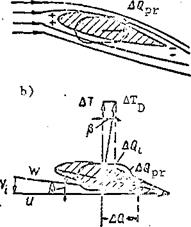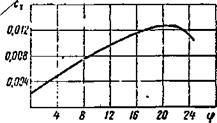Forces Resisting Rotation of the Main Rotor
The forces resisting rotation are called the aerodynamic forces operating in the plane of rotation of the hub and directed against the rotation.
At each blade element, its own element of force arises to resist rotation.
In a similar way to the drag force of a wing, the elements of the forces re – .
sisting rotation consist of the forces of profile and induced drag.
Profile rotational resistance AQ^ is an aerodynamic force that arises because of the difference of air pressure in the forward and aft parts of the blade, and also due to the friction of the air in the boundary layer. In general, the profile drag depends on the number of revolutions of the main
|
Figure 16. Relationship between the thrust coefficient and the pitch of the main rotor. |
deflected elementary thrust force ЛТ is
rotor, the condition of the blade surface and the form of the profile. It is changed very little by changes in the pitch of the rotor (Figure 17a).
Induced resistance arises owing to the induced cross flow on the blade of the main rotor. The induced cross flow deflects the vector of elementary thrust force by an angle 6 backwards relative to the axis of the hub (Figure 17b). If the vector of the projected on the rotation plane of the
hub, we obtain the vector of an elementary induced force that resists
rotation ДО..
x
The induced rotational resistance depends, principally, on the pitch of the main rotor (with an increase in pitch, it increases). Profile and induced drag, just like the thrust force, depend on air density.
The reactive moment of the main rotor. The elementary rotational resistance forces arise on each element of the blade. Combining the elementary /21
forces of one blade, we obtain their resultant Q = ZAQ (Figure 17c).
b
Since the forces resisting rotation are directed opposite the rotor rotation, their geometric sum (resultant) is zero and does not lead to translational motion of the main rotor. But the forces resisting rotation create a torque about the hub axis, termed reactive, and sometimes termed the rotational resistance torque (see Figure 17c)
Mr = Qbr<A
|
|
||
|
|||

|

The reactive torque depends on those same factors which determine the magnitude of the forces resisting rotation, i. e., rotor pitch, rotor rpm, blade surface condition and shape, and air density.
The reactive torque is directed opposite the rotor rotation, consequently this torque is a retarding torque; it tends to stop the rotor and reduces its angular velocity of rotation.














